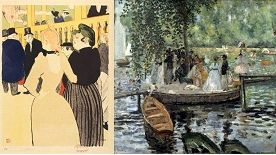
Press release -
Modern Life at Nationalmuseum this spring
From 19 April, visitors will be able to see Nationalmuseum’s extensive collection of French 19th-century art presented in a new way. The exhibition charts the modern way of living that emerged during that period and how it influenced art. It forms part of a project to test out future ways of presenting the museum’s collections in the refurbished building.
Modern Life – France in the 19th Century tells the story of how French society embraced the modern age during the 19th century and what impact that had on the art movement. The time provides a common theme for the exhibition, with social issues and dramatic events driving the story forward, from the French Revolution in 1789 to the outbreak of the First World War in 1914. Nationalmuseum’s collection includes a rich gallery of figures who helped to create what we might consider modern life, with portraits by both French and Swedish artists such as Edouard Manet, Anders Zorn, Edgar Degas, Auguste Renoir, Eva Bonnier and Auguste Rodin.
The 19th century saw the industrial revolution, mass migration to the cities, popular revolts and the emergence of democracy. With all these changes came new ways of looking at people and society. A fascination for the growing wealth of entertainment and goods on offer in the cities developed, alongside a new way of viewing the natural world. The new penchant for plein air painting and the impressionists’ experiments with light and colour led to a deeper realism in the depiction of nature. Towards the end of the 19th century, the new inventions and fashions of the age started making increasingly frequent appearances in landscape paintings – trains steaming by, holidaymakers strolling along glittering beaches and leisure spots punctuating the banks of the Seine. In the field of applied art, nature inspired elegant designs decorated with stylised plants and flowers, as well as rugged shapes and rough surfaces.
The works of Swedish artists and their sojourns in France are also woven into the exhibition. Many Swedish artists travelled to Paris in the second half of the 19th century, and the little town of Grez-sur-Loing became home to an international artists’ colony. Works from artists such as Eva Bonnier, Karl Nordström, Carl Fredrik Hill and Ernst Josephson are here for all to see.
The exhibition is part of a project looking at how to present the Nationalmuseum’s collections in the refurbished museum, once work is completed. The exhibition is thus testing out new forms of presentation and ideas that will then be assessed and help to determine how the art will be displayed in the future. One idea being trialled in collaboration with the Getty Conservation Institute is the use of LED lighting.
All the works in the exhibition come from Nationalmuseum’s own collection, with the exception of a few photographs that are on loan. Paintings, sculptures, drawings and applied art will appear side by side, with objects placed closer together than usual so that more works can be put on show. The presentation will be supported by texts about individual pieces, slideshows, moving images and touchscreens. More information about the exhibition, particular works and related activities will be available online and via Twitter. A book group will also be organised during spring and autumn in conjunction with the exhibition.
The exhibition will run from 19 April onwards.
Further information
Veronica Hejdelind, exhibition curator, veronica.hejdelind@nationalmuseum.se, +46 8 5195 4393
Mikael Ahlund, exhibition curator, mikael.ahlund@nationalmuseum.se, +46 8 5195 4454
Hanna Tottmar, press officer, hanna.tottmar@nationalmuseum.se, +46 8 5195 4390, +46 767 23 46 32
Press images
www.nationalmuseum.se/pressroom
Captions
Ceramic in front of Landscape from Bretagne by Paul Gauguin; Henri de Toulouse-Lautrec, At Moulin Rouge. La Goulue and her sister; Auguste Renoir, La Grenouillère.
Categories

